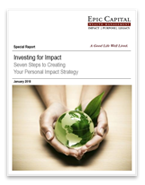Market Update – More Pullback Perspective
Aug 9, 2024
 This latest bout of market volatility has been unsettling, especially after such a calm 2023 and 2024 for stocks. However, with the benefit of some historical perspective, volatility of this magnitude is quite common.
This latest bout of market volatility has been unsettling, especially after such a calm 2023 and 2024 for stocks. However, with the benefit of some historical perspective, volatility of this magnitude is quite common.
That said, Monday morning’s brief spike in the CBOE Volatility Index (VIX) to over 60, which we wrote about in “Navigating the Storm: Insights on Current Market Volatility”, was certainly not normal. Now that this measure of implied volatility based on S&P 500 option prices is back to more normal levels in the low 20s after closing at 38.6 on Monday, it’s fair to say this pullback has been typical. We explain below.
The S&P 500 has just experienced its second 5% pullback of the year. The maximum year-to-date drawdown (peak-to-trough decline) is just 8.5%. On average, the index experiences three drawdowns of between 5% and 10% each year. Corrections of 10–20% are also quite common, having occurred once per year on average. So, 2024 is not shaping up to be a typical year.
One of our favorite charts illustrates this point. Since the 1980s, the S&P 500 has experienced a maximum intra-year correction of 14%, on average, while the index has produced an average gain of 13%. Though this latest pullback happened fast and felt significant, history suggests it really was not. In fact, this widely followed large cap index is barely over halfway to the average drawdown. Even in up years, the average maximum drawdown is 11%, so we are not even there yet. After stocks rebounded yesterday and this morning, the S&P 500 is less than 7% off its July 16 record high.
S&P 500 Intra-Year Corrections

Source: LPL Research, FactSet 08/06/24
Disclosures: Indexes are unmanaged and cannot be invested in directly. Past performance is no guarantee of future results.
Even in election years, the volatility profile doesn’t seem much different. Since 1950, the average maximum drawdown for the S&P 500 during election years has been 12.8%. We may still get there given the economic and political/geopolitical uncertainty and seasonal weakness, but the point still holds. This volatility is normal. It’s like paying a necessary toll on the road to attractive long-term results.
For the chart below, we added the average gain in the S&P 500 one year after the election-year lows. At 21%, we think it’s fair to be optimistic about a rebound in stocks this year after interim lows are set. Historical seasonal analysis suggests those lows are likely to come in September or October.
Post-Election Rallies Tend to Follow Modest Election-Year Corrections (1950–2024)
Pullbacks and Performance One Year off S&P 500 Lows Based on Four-Year Presidential Cycle

Source: LPL Research, FactSet 08/06/24
Disclosures: Indexes are unmanaged and cannot be invested in directly. Past performance is no guarantee of future results. The modern design of the S&P 500 was first launched in 1957. Performance before then incorporates its predecessor index, the S&P 90.
Summary
Elevated volatility and stock market drawdowns can be unnerving, but the market tends to reward individuals who stay invested, are patient, and do not panic. LPL’s Strategic and Tactical Asset Allocation Committee (STAAC) maintains its tactical neutral stance on equities while actively monitoring signs the bottoming process is playing out. While we remain cautious, potential triggers for a stock market recovery include Fed signals that they may be more aggressive with rate cuts, more evidence that the U.S. economy is not falling off a cliff, and stability in the global currency markets — particularly regarding the volatile Japanese yen. Markets may also refocus on company fundamentals and share buybacks in the coming weeks as the rest of corporate America reports second-quarter earnings. Finally, most sentiment indexes reflect pessimism, which have historically been bullish contrarian indicators.
For more insights and resources, be sure to sign up for our Weekly Market Commentary. Follow our YouTube channel where we regularly post our Epic Market Minute videos. Follow us on LinkedIn, or like us on Facebook. And as always, please don’t hesitate to reach out to a dedicated service professional at Epic Capital.
Important Disclosures
This material is for general information only and is not intended to provide specific advice or recommendations for any individual. There is no assurance that the views or strategies discussed are suitable for all investors. To determine which investment(s) may be appropriate for you, please consult your financial professional prior to investing. Investing involves risks including possible loss of principal. No investment strategy or risk management technique can guarantee return or eliminate risk. Indexes are unmanaged and cannot be invested into directly. Index performance is not indicative of the performance of any investment and does not reflect fees, expenses, or sales charges. All performance referenced is historical and is no guarantee of future results. This material was prepared by LPL Financial, LLC. All information is believed to be from reliable sources; however LPL Financial makes no representation as to its completeness or accuracy. Unless otherwise stated LPL Financial and the third party persons and firms mentioned are not affiliates of each other and make no representation with respect to each other. Any company names noted herein are for educational purposes only and not an indication of trading intent or a solicitation of their products or services. Asset Class Disclosures – International investing involves special risks such as currency fluctuation and political instability and may not be suitable for all investors. These risks are often heightened for investments in emerging markets. Bonds are subject to market and interest rate risk if sold prior to maturity. Municipal bonds are subject and market and interest rate risk and potentially capital gains tax if sold prior to maturity. Interest income may be subject to the alternative minimum tax. Municipal bonds are federally tax-free but other state and local taxes may apply. Preferred stock dividends are paid at the discretion of the issuing company. Preferred stocks are subject to interest rate and credit risk. They may be subject to a call features. Alternative investments may not be suitable for all investors and involve special risks such as leveraging the investment, potential adverse market forces, regulatory changes and potentially illiquidity. The strategies employed in the management of alternative investments may accelerate the velocity of potential losses. Mortgage backed securities are subject to credit, default, prepayment, extension, market and interest rate risk. High yield/junk bonds (grade BB or below) are below investment grade securities, and are subject to higher interest rate, credit, and liquidity risks than those graded BBB and above. They generally should be part of a diversified portfolio for sophisticated investors. Precious metal investing involves greater fluctuation and potential for losses. The fast price swings of commodities will result in significant volatility in an investor's holdings. Securities and advisory services offered through LPL Financial, a registered investment advisor and broker-dealer. Member FINRA/SIPC. Not Insured by FDIC/NCUA or Any Other Government Agency | Not Bank/Credit Union Deposits or Obligations | Not Bank/Credit Union Guaranteed | May Lose Value
Tags: Current Events, financial advisor, financial advisor charlotte nc, Investment Portfolio, Stock Market
More Insights
Few terms in personal finance are as important, or used as frequently, as “risk.” Nevertheless, few terms are as imprecisely defined. Generally, when financial advisors or the media talk about investment risk, their focus is on the historical price volatility of the asset or investment under discussion.
As Americans get their grills and beach chairs ready for the July 4th holiday, the stock market and the weather across much of the country have both been on heaters. Stocks and bonds continue to effectively navigate a complex policy landscape shaped by evolving trade dynamics, geopolitical tensions, and fiscal stimulus. The market’s resilience in … Continue reading “Market Update – America Gets Record High Stock Prices for Its Birthday”
Birthdays may seem less important as you grow older. They may not offer the impact of watershed moments such as getting a driver’s license at 16 and voting at 18. But beginning at age 50, there are several key birthdays that can affect your tax situation, health-care eligibility, and retirement benefits.
During times like these when geopolitical headlines can be unsettling for investors, we at LPL Research like to remind ourselves of one of our key investing principles. Markets have always faced challenges —ranging from geopolitical conflicts and economic downturns to natural disasters, political upheaval and health crises. These events often trigger short-term volatility and shake … Continue reading “Why Long Term Investing Beats Selling in Volatile Times”
Are you concerned about the inheritance taxes your heirs may have to pay? Then you may want to consider creating charitable lead trusts.
Services
Epic Capital provides the following comprehensive financial planning and investment management services: Learn More >


 Top of Page
Top of Page











